|
수와
당의 시조가 모두 만주 선비족 출신이라면?
Founders of the Sui and Tang
Dynasties
수 나라 시조 양견은, 명확하게 선비족 출신이라는 기록은 없지만, 만주의 선비족이 세운 북위, 서위, 북주
등을 대대로 섬겨온 귀족가문 출신이었다. 양견의 아내인 문헌황후는, (拓跋鮮卑) 북위의 황실 및 대 호족들과 대대로 혼인관계를 맺어온 선비 씨족
출신인 독고신(獨孤信)의 딸이다. 독고신은 우문선비(宇文鮮卑) 씨족의 우문태를 따라 서쪽으로 가서, 서위(후에 북주)를 세우는데 큰 공을
세웠다. 독고신의 맏딸은 북주의 첫 번째 황제인 (宇文泰의 아들) 명제와 결혼을 했고, 일곱 번째 딸은 수 문제와 결혼을 했고, 넷째 딸은 당
고조 이연(李淵)의 아버지와 결혼을 하였다 이씨 가문은 (후에 당 조정이 漢族 명문가의 후예로 조작을 했지만) 선비족 혈통의 씨족 이었다
(Wechsler, 1979: 151) 이연의 할아버지는 북위의 유명한 장수의 후예이며, 우문태가 자립하여 북주를 창건하는데 큰 공을 세워
당국공(唐國公)에 봉해졌다. 이연의 모친과 수 양제의 모친은 자매 사이인 것이다. 본 연재는 영문과 국문번역을 동시에 제공한다.
Text In PDF .../편집자 주
| |
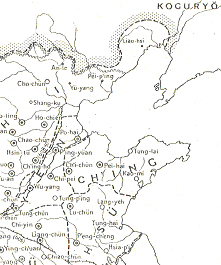 |
|
|
| ▲ Sui in 609 Twitchett
(1979: 129) |
| 수(隋)와 당(唐) 시조(始祖)들의 혈통을
추적
수와 당의 시조가 모두 만주 선비족 출신 이라면?
홍원탁 (서울대 교수)
선비족의 언어를 배우는 북중국 한족(漢族)들
북위(北魏, 386-534)는 서위(후에
北周가 됨)와 동위(후에 北齊가 됨)로 갈라졌다. 변경지역의 한족들 대부분은, 초원 지역에서 왔건 삼림 지역에서 왔건 그 당시에 우세한 종족에
빌붙어서 삶을 영위하였다. 이들 한족들의 전형적인 처신을 확인해주는 중국의 자료들이 있다. 북제 (550-77) 시대에 쓰여진 기록 중,
“조정의 사대부(士大夫) 하나가 나에게 어느 날 ‘내게는 이미 17살이 된 아들이 하나 있는데 서신과 공문서 작성을 꽤 잘한다. 나는 지금
그에게 선비족의 언어와 비파 타는 법을 가르쳐 주고 있다. 내 아들이 이런 것들을 잘 배워 조정의 공경(公卿)들에게 쓸모가 있게 되면 그들의 덕을
볼 수 있을 것이기 때문에, 나는 내 아들이 이런 것을 배우기를 원한다’고 말했다 ”는 기록이 있다. 1
선비(鮮卑)적인 요소가 가장 강하게 남아있던 서위는 557년에 북주가 되어, 577년에는 북제를
멸하고, 579년에는 진(陳)의 강북 땅을 빼앗아, 잠시 북중국을 재통일하였다. 수(隋, 581-618) 왕조는 우문선비 북주의 후계자로서
천하를 통일 한 것이다.
수의 중국 본토 통일과 돌궐 연맹체의 출현
402년, 몽골은 유연(柔然) 카간의 영도 하에 중앙집권적 국가를 세웠으나, 북위는 국경지대에 대규모의 수비대를 주둔시킨 다음, 오히려
몽골을 침략하여 양껏 사람과 가축들을 잡아갔다. 탁발선비 조정은, 494년에 수도를 낙양으로 옮기고 완전히 중국화되어 버린 후에야 비로서
유화정책을 채택하기 시작하여, 몽골의 지배자와 (처음에는 유연의 제후 노릇을 하던) 돌궐족에게 뇌물을 바치기 시작했다. 2
유연의 몽골은 결국 552년에 돌궐에 의해 멸망되었다. 알타이산맥 인근 지역에서 유래하는 이 돌궐 족들은 6세기 말에 이르러 두 개의
거대한 제국을 건설하였다. 동돌궐은 훗날 카라코룸이 위치하게 되는 오르콘 강 상류에 도읍을 정하고, 카간이라는 황제칭호를 사용하였다. 서돌궐은
그보다 낮은 야브쿠라는 칭호를 사용하면서, 자신의 제국을 알타이 산맥으로부터 페르시아와 카스피해까지 넓혔다. 중국 본토가 수 나라에 의해 통일이
되어갈 즈음, 북방 전선에는 돌궐 연맹체가 형성되어, 마치 한 나라가 흉노를 대치했던 상황을 연상하게 되었다. 3
선비족 왕조를 섬기던 가문 출신으로 선비족 아내를 얻은 수 문제(文帝) 양견(楊堅)
수 나라를 세운 양견은, 선비족의 북위, 서위(535-56), 북주(556-81) 등을 대대로 섬겨온 귀족가문 출신이었다. 양견의 아내인
문헌(文獻)황후는, 북위의 황실 및 대 호족들과 대대로 혼인관계를 맺어온 선비 씨족 출신인 독고신(獨孤信)의 딸이다. 독고신은 우문태(宇文泰)를
따라 서쪽으로 가서, 우문태가 (文帝를 옹립하여, 후에 북주가 되는) 서위를 창건하는데 큰 공을 세웠다. 독고신의 맏딸은 북주의 첫 번째 황제인
(우문태의 아들) 명제(明帝: 557-60)와 결혼을 했고, 일곱 번째 딸은 수 문제(581-604) 양견과 결혼을 했고, 넷째 딸은 당 고조(高祖, 618-26) 이연(李淵)의 아버지와 결혼을 하였다. 4
양견이 581년에 북주를 인수하였을 당시에는 선비족 혹은 선비족과 혼혈관계를 맺고 있는 군(軍) 귀족 씨족들이 실세를 장악하고 있었다.
Twitchett(1979: 81)에 의하면, “북주의 고위 관료 중 65%는 비한족 출신이었다. 수 문제 자신도 이러한 체제하에서
성장하였으며, 그의 친구들과 최 고위 참모들 대부분은 바로 이 비한족 집단 출신이었다.”
수 문제는, 589년에 중국 전체를 통일하자, 북위 말기 이래 막대한 양의 비단을 돌궐 카간에게 바쳐오던 관행을 중단시키고, 초원지대에서의
내부적인 반목과 분열을 적극 조장하였다. 중국 본토는 통일이 되었는데, 돌궐족은 내분으로 분열되고 있었다. 5 수 문제는, 단순히 내분을
교묘히 조작하는 방법으로 돌궐 세력을 분열시키면서, 말을 안 듣는 칸들은 제거하고 나머지 칸들은 신속(臣屬)시킬 수 있었다.
고구려는, 한나라 때 고조선 모양, 요하 동쪽의 만주뿐 아니라 한반도 북부도 차지하고, 수도를 평양에 두었다. 고구려는 먼저 수 나라에
적대행위를 취해, 요하를 건너 공격하였다. 수서(隋書)에 의하면, 고구려 영양왕은 598년에 1만 명의 말갈 기병을 이끌고 영주(榮州, 朝陽)를
공격한 것이다. 6
598년, 문제는 30만 명의 육군과 수군을 동원하여, 막내 아들을 최고 사령관으로 임명하고, 고구려에 대대적인 공격을 단행하였다. 이
원정에서 살아 남아 고국으로 돌아간 수 나라 군대는 20%도 되지 않았다. 605년, 양제(煬帝, 604-18)는 돌궐족 2만 명을 보내
거란족을 쳐부순 다음, 고구려에게 자신의 신하가 되어 복종하지 않으면 돌궐족을 동원하여 공격 하겠다고 위협했다. 그러나 607년에 돌궐족의
지휘본부를 방문했을 때, 양제는 카간이 고구려에서 온 사신과 협상을 하고 있는 것을 발견했다. 7
양제는 서둘러 항주로부터 북경 근처까지 대 운하를 확장하였다. 611년, 수 양제는 (백만 명이 넘었다는) 역사상 최대 규모의 군대와 막대한
보급물자를 집결시킨 다음, 자신의 불운을 탓하게 된 요동 공격을 개시했다.
요하 동안(東岸)을 따라 설치된 고구려 요새들은, 늦여름의 장마가 시작되어 수 나라의 군사작전이 더 이상 불가능하게 될 때까지 버텨냈다.
수 나라 군대가 요동성(지금의 요양)을 함락시키지 못하자, 양제는 수 나라 원정군의 1/3인 30만 명을 떼어 내, 평양을 직접 공격하도록
했다. 그러나 수 나라 군대는 을지문덕 장군의 계략에 말려들어 살수(청천강)에서 비참한 패배를 당하였다. 압록강을 건너왔던 30만 명의 수 나라
군대 중에서 살아 돌아간 숫자는 2,700명에 불과했다고 기록이 되어 있다. 양제는 요동성의 포위를 풀고 낙양으로 돌아갈 수 밖에 없었다.
8
613년에 수 나라 군대는 다시 요하를 건넜으나, 전투가 진행되는 가운데 양현감이 반란을 일으켰다는 소식을 전해 듣고 양제는 또다시 철군을
하지 않을 수 없었다. 614년에 양제의 군대가 세 번째로 요하를 건넜으나, 이번에도 고구려 요새들을 함락시키지 못했다. 그는 네 번째로 원정을
떠나기 위해 군에 동원령을 내렸으나, 이미 전국이 반란으로 소용돌이 치고 있었다.
매번 거듭 패할 때 마다, 고구려 정복에 대한 양제의 집념은 커져만 갔다. 하지만 모든 출정이 너무나도 비참하게 끝났기 때문에, 오래지
않아 전쟁으로 피폐한 제국 자체가 멸망하게 되었다. 9 강력했지만 단명으로 끝난 수
왕조(581-618)는 당 왕조(618-906)로 대체되었다.
| |
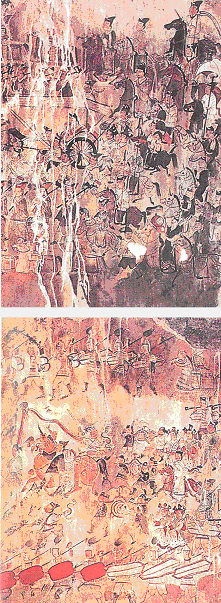 |
|
|
| ▲ Koguryeo An-ak Tomb
No. 3 |
| 수 문제의 조카이며, 수 양제의 사촌인, 당 고조
이연(李淵)
Wechsler(Twitchett, 1979: 150-1)에 의하면, 이연(당 고조, 618-26)은 선비족 혈통의 이씨 가문 출신이었다.
이연의 모친과 수 양제의 모친은 자매 사이였다. 이연은 수 문제의 각별한 총애를 받았으며, 양제의 사촌으로, 당시 가장 세력이 큰 장수들 중의
하나이었다. 이연의 할아버지인 이호(李虎)는, 북위의 유명한 장수의 후예이며, 557년에 북주를 창건하는데 큰 공을 세운 팔주국(八柱國,
우문태가 556년에 죽기 직전에 자립을 시도할 때 가담한 장수들) 중 한 명이 되어, 558년에는 당국공(唐國公)에 봉해졌다. 이연은 할아버지
이호의 당국공 칭호를 물려받았다. 그 당시 이씨 씨족들은, 북위가 오늘날 대동(大同)이라 부르는 지역 부근에 설치한 수비대의 주둔지역에 집중되어
있었고, 그 지역은 바로 우문태의 본거지이기도 하였다.
문헌황후 언니의 아들인 이연은 일찍부터 남이 따를 수 없는 출세길이 보장되어 있었다. 그러나 태원(太原) 수비대의 사령관이었던 이연은,
돌궐의 카간과 밀약을 맺은 다음, 큰아들 건성(建成, 후에 황태자로 임명)과 둘째 아들 세민(世民, 후에 형을 죽임)을 데리고 태원에서 군대를
끌고 나와 수 나라의 수도를 점령했던 것이다.
구당서에 의하면, 이연은 동돌궐 카간 시피의 지원을 구할 때 “사람과 영토는 당국공인 나에게 속하지만, 모든 재물, 비단, 금은보화들은
돌궐에 귀속된다”고 선언하였다. 이 기록을 보고, Jagchid와 Symons(1989: 69)는 “간단히 말하자면, 시피 카간은 당 나라
시조로부터 중국에 있는 동산(動産)을 모두 차지할 수 있다는 약속을 받아 낸 것”이라고 말한다. 카간이 이연의 거사에 합류한 목적은 중국 땅을
점령하려는 것이 아니고, 중국의 재물을 차지하려는 것이었다. 훗날 태종은 무심코 이 비밀을 누설했다: “예전 우리 왕국의 창건 당시,
태상황제(고조)께서 오로지 백성들 때문에 돌궐의 신하가 되었다(稱臣於突厥). 이 (부끄러운 사실을) 어떻게 우리가 마음속으로부터 증오하지 않을
수 있는가? 우리는 흉노를 섬멸해야 한다. 10 (전계서: 70). ”
| |
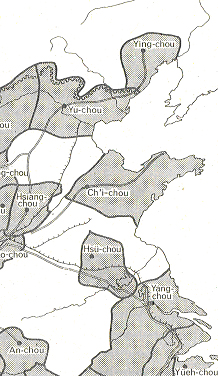 |
|
|
| ▲ Tang in 639 Twitchett
(1979: 204) |
| 북중국 귀족 씨족들의 종족적인
뿌리
북중국 귀족 씨족들의 종족적인 뿌리는 선비족, 돌궐족과 옛 변방 한족들의 혼합이다. 그들은 상무정신을 강조하였고, 직접 전투와 사냥에
참가하는 것을 높게 평가하였다. 11 반면, 대부분 북에서 도망을 해 온 집단인 남조의 지배 씨족들은 자신들이야말로 진정한 한족 문화전통의
후계자라고 믿었다.
태종 이세민은 초원지대의 정치게임에 정통하였으며, 초원지대 문화와 전통에 심오한 지식을 가지고 있었다. 그는 유목민들의 전법에도
숙달하였다. Barfield (1989: 141)는 이세민이 “전략적인 후퇴에 능하여, 공격하기 전에 수적으로 우세한 적군을 우선 지치게
만들었다. 그는 몸소 군대를 이끌고 전쟁에 참여했고, 타고 있던 말이 네 마리나 죽었다. 그는 말들의 죽음을 애통이 여겨, 석상(石像)을 만든
다음, 화살을 몇 개나 맞았고 부상이 어떠했는가 뿐만 아니라, 그 말들 하나하나의 신체적 특징을 세밀하게 기록했다. 말과 전쟁에 대해 이렇게
세세한 관심을 갖는 것은 유목민 지도자들의 특징이라고 말한다.
수 나라뿐만 아니라 초기의 당나라 조정도 일찍이 북위 왕조의 지배하에 그 실효성이 증명된 제도를 그대로 답습하여 제국을 조직하였다. 당나라
초기의 통치제도는 유목민의 군대-문민 이원제를 답습한 것이었다. Barfield(1989: 140, 142)는 북중국은 오랜 기간 동안 이민족의
통치를 받으면서 “야만화(野蠻化)”가 철저하게 진행되었기 때문에, 태종이 중국본토와 목초지대 모두를 통치할 수 있었던 것이라고 말한다.
당나라 깃발 아래의 돌궐족
돌궐족들은 당나라 통치 아래로 들어오거나 아니면 서쪽으로 달아났다. 돌궐 군대가 뒷받침 하는 중국식 통치조직은 당나라의 세력을 최고조에
달하게 만들었다. 당나라의 깃발 아래로 들어간 돌궐의 전투전문가들은 중국의 국경을 중앙아시아까지 확장시켰다. 이세민은 중국 땅의 카간인 동시에
중앙아시아의 지배자가 되어, 648년에는 파미르 고원도 당나라가 직접 지배하게 되었다. 그러나 동이족과는 전혀 얘기가 달랐다. 태종은 고구려와의
전쟁에서 치욕적인 패배를 경험하게 된 것이다.
| |
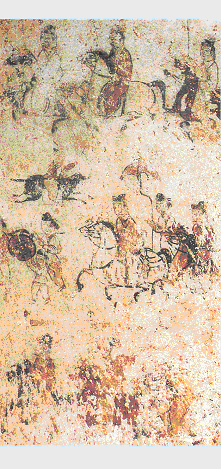 |
|
|
| ▲ Koguryeo Tomb
Painting Yak-su-ri, Kang-seo, Nampo City |
| 고구려와 전쟁에서의 당나라의
참패
645년, 태종과 이세적(李世勣)이 이끄는 군대가 요동을 향하여 진군하였다. 구당서에 의하면, 태종은 요동성 아래의 해자를 메우기 위해
손수 가장 무거운 흙 자루를 날랐으며, 장수 한 명이 화살을 맞고 부상을 당하자 몸소 상처의 피를 빨아주었다 한다. 그러나 공격군은 안시성에
이르러 진군을 멈추게 되었다. 태종은 장수들을 직접 지휘하며 공격을 독려했다. 당나라 군대는 하루에 6-7번이나 공격을 반복 할 정도로 전력을
투입했다. 하지만 두 달에 걸친 공격도 허사로 끝이 나고, 혹독한 겨울이 닥쳐오자 이세민은 철군을 명령할 수밖에 없었다. 12
647년 초, 태종은 다시 한번 고구려를 공격하였으나 별 성과를 거두지 못했다. 태종은 다음해 648년에 30만 대군을 일으켜 고구려를
완전히 격파하겠다고 선언을 했다. 하지만 자신 생애 단 하나의 참패에 대한 통분의 한을 품고 태종은 다음해에 죽었다.
구당서를 편찬한 사관(史官)은 다음과 같이 평하였다: “수 양제가 만족을 모르는 끝없는 욕망으로 요동에 군사를 일으켜 드디어는 나라까지
망치고 말았다. 태종이 고구려를 정벌한 것도 얻은 것은 적고 잃은 것이 많았다. 태종 자신도 출사(出師)를 후회하였다. 자갈밭인 야만족 땅은
정복하더라도 쓸모가 없으며, 버려두더라도 잃을 것이 없다. 허영심 때문에 쓸데없이 헛고생만을 했구나! 통역을 거쳐서 조정에 오게 하고, 바다를
건너서 들어와 조공을 바치게 하는 것이 옳은 방법일 것이다.” 13
이세민의 뒤를 이은 고종(649-683)은 심신이 병약하였다. 황후인 무후(則天武后)는 처음에는 (660-683) 고종을 통해 중국을
다스리다가, 고종이 죽자 자신의 어린 아들들을 내세워 다스렸으며(684-690), 막판에는 아예 새로 주(周, 690-705) 왕조를 세워
여황제가 되었다.
북중국의 귀족 씨족들은 대부분 한족이 아니었으며, 그들은 중앙정부의 고위직을 거의 모두 차지하였다. 비록 수 나라 때 과거제도가 도입은
되었지만, 실제 관리 임용에 있어 결정적인 역할을 하지 못하였다. 그러나 고종 때부터, 당 나라는 세습적 귀족 씨족에 의한 지배체제로부터 과거를
통해 선발된 관료들에 의한 지배 체제로 바뀌기 시작하였다.
| |
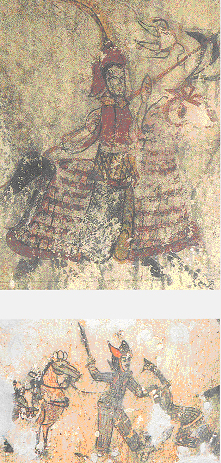 |
|
|
▲ Koguryeo Tomb
Paintings
(top) Deok-heung-ri, Nam-po City
(bottom) Ji’an Tomb No.
12 |
| 당나라의 영광: 역사가들에 만들어 낸
신화
고구려와 전쟁에서의 참패가 태종 자신의 이미지를 크게 손상시켰음에도 불구하고, 역사가들의 마음속에서는 당나라의 영광이 조금도 손상 받지
않았다. 하지만 이세민의 사후, 특히 [백제와 고구려를 멸망시킨] 무후(661-705)의 통치 이후, 당나라 군사력의 쇠퇴 현상은 현저하게
나타나기 시작했다. 상무적인 귀족 씨족들에 의한 통치는 나약한 관료들에 의한 통치로 전환된 것이었다.
무후의 뒤를 이은 황제들은 돌궐족의 침입을 회피해 보려고, 공주를 시집 보내고, 선물과 보조금을 제공하였다. 안록산의 난으로부터 시작된
일련의 난(755-63)을 겪은 후, 당 조정의 통치는 유명무실해졌다. Fairbank(1992: 86)는 “중앙정권의 실제 공백기간은
755년의 반란 이후 979년까지 지속되었다”고 말한다. 현대 역사가들이 정성을 들여 창조한 신화와는 반대로, 당 왕조의 정치력과 영광은 그
생명이 매우 짧았었고, 여인의 통치라는 체면 손상도 있었다.
동아시아 역사 강의: 3-1 (2005. 7. 23)
정리: 강현사 박사
ⓒ 2005 by Wontack
Hong
All rights reserved
BIBLIOGRAPHY
http://www.EastAsianHistory.pe.kr
http://www.WontackHong.pe.kr
[각주]
1. 북제 시대의 안지추(顔之推)가 쓴 안씨가훈(顔氏家訓)에서 인용.
Schreiber(1949-5:
388)는 “정치적 출세를 위해, 보다 좋은 기회를 확보하는 수단으로서, 기초적인 선비족 언어의 지식을 자신의 아들에게 가르친다는 사실은,
지배계층인 탁발 부족이 선비족 언어를 사용했을 경우에만 타당성이 있는 얘기가 된다”고 말한다. Schreiber(ibid: 390-1)는 또,
노래를 부르고 비파 연주를 무척 좋아한다는 사실이 선비족의 가장 눈에 띄는 특징임에 틀림이 없으며, 선비족 노래를 모아 놓은 2권의 노래책은
선비족들이 노래를 좋아한다는 사실을 증명 해 주고 있다고 말한다
齊朝有一位士大夫 曾經對我說 我有一個孩子 已經十七歲了 懂得一些書信公文的書寫 我敎他學習鮮卑語和彈琵琶 只要稍稍
掌握一些 就可以用這些本領去 爲公卿們效力了 沒有不受寵的道理 這也是一件很重要的事情 (顔之推: 顔氏家訓)
2. 유연의 지배자들은, 돌궐 전통으로 볼 수 있는 옛 흉노족 칭호인 선우(鮮于) 대신에, 몽골식 칭호인
“칸”과 “카간”을 사용하였다. Barfield (1989: 120-3) 참조.
3. Ledyard (1983: 320) 참조. 흉노는 중세 터키족의 조상이었을 것으로 생각되며, 터키어의
초기형태언어를 사용했다. 그러나 몽골 언어 속에 들어 있는 수 많은 터키 차용어의 존재는, 언젠가 몽골의 언어적 조상이, 막강한 문화적 정치적
세력을 보유한 돌궐족에 의해 지배를 받았던 시기가 있었음을 암시한다. 반면, 몽골 언어와는 대조적으로, 만주의 퉁구스어는 터키어와 유사한 어휘가
거의 없다. Janhunen (1996: 172, 183, 186)과 Ostler (2005: 140) 참조.
4. Twitchett (1979: 63-4, 151) 참조
魏書 卷一 序紀第一
…國有大鮮卑山…北俗謂土爲托 謂后爲跋 故以爲氏…至成皇帝…立 統國三十六 大姓九十九
周書 卷十六 列傳第八 獨孤信 …雲中人也 魏氏之初 有三十六部 其先…者爲部落大人 與魏俱起 祖 …和平[北魏,
460-5]中… 父…爲領民酋長… 信…善騎射… 建明[北魏, 530-1]初... 信爲大都督 ...信與
[北周]太祖[d.556]鄕里 少相友善
相見甚歡..[北]魏孝武[532-4]雅相委任.. [西]魏文帝[535-51]付尙 書議之 ...可轉驃騎大將軍..[北周]太祖令信率..討之... [北周]
孝閔帝[556-7]...進封衛國公... 信長女周明 敬后 第四女 元貞皇后 第七女 隋文獻后 周隋及皇家 三代皆爲外戚 自古以來
未之有也
隋書 卷三十六 列傳第一 后妃 文獻獨孤皇后 周大司馬河公信之女也 信見高祖有奇表 故以后妻焉..
后姊爲[北]周明帝[557 -60]后 長女爲[北]周宣帝[578 -80]后
舊唐書 卷一 本紀 第一 高祖 …姓李氏 諱淵..皇祖諱虎…與周文帝及..大司馬獨孤信等以功 參佐命 當時稱爲八柱國家…
周受禪 追封唐國公...廟號太祖 ... 皇考諱昞 [北]周安州總管... 廟號世祖…襲唐國公…追尊元皇帝 廟號世祖…高祖七歲襲唐國公… 文帝獨孤皇后
卽高祖從母也
5. Barfield (1989: 136-38)
6. 隋書 卷八十一 列傳 第四十六 東夷 高麗 開皇十八年 元率靺鞨之衆萬餘騎寇遼西 榮州總管韋沖擊走之
高祖聞而大怒 영주는 만리장성 밖에 위치해 있으며, 570년대 이래 고보녕(高寶寧)이 점거하고 있었다.
7. 三國史記 高句麗本紀 第八 嬰陽王 九年 王率靺鞨之衆萬餘 侵遼西 …隋文帝聞而大怒
命…將水陸三十萬來伐…軍中乏食 復遇疾疫 師還 死者十八九 十八年 初煬帝之幸啓民 帳也 我使者在啓民所..與之見帝….帝…宣旨曰…苟或不朝…往巡彼土 …
啓民突厥可汗也
8. Lee (1984: 47)
9. Twitchett (1979: 143-9)
10. 舊唐書 列傳第七 劉文靜 ...使于始畢可汗 …皇帝….起義軍...願與可汗兵馬同入京師 人衆土地入唐公
財帛金寶入突厥
舊唐書 列傳第十七 李靖 ... 太宗…曰 … 太上皇以百姓之故 稱臣於突厥 朕未嘗 不痛心疾首
志滅匈奴
11. Barfield (1989: 140)
12. Lee (1984: 48) 참조. 629년, 태종은 이세적(李世勣)을 고비사막으로 보내 동돌궐을
정복하였다, 이세적의 본래 성씨는 서씨(徐氏)였으나 고조(高祖) 이연(李淵)이 이씨 성을 하사 해 주었다. 이름도 본래 세적(世勣)인데, 태종의
이름 세민(世民)의 ‘세’자를 피하여 그냥 “적”이라 부르게 되었다.
13. 舊唐書 列傳 第一百四十九 渤海靺鞨 史臣曰 隋煬帝 縱欲無厭 興兵遼左 … 遂亡其國 我太宗文皇帝 親馭戎輅
東征高麗 雖有成功 所損亦甚 …悔於出師… 夷狄之國 猶石田也 得之無益 失之何傷 必務求虛名 以勞有用 但當修文德以來之 被聲敎以服之 擇信以撫之
謹邊備以防之 使重譯來庭 航海入貢 玆庶得其道也 (CCII: 385, 404)
Founders of the Sui and Tang Dynasties
tracing their roots to the xianbei
Wontack Hong
Professor, Seoul University
the han chinese learning the xianbei language
The Northern Wei (386-534) was divided into the Western Wei (which became the
Northern Zhou), and the Eastern Wei (which became the Northern Qi). The frontier
Han Chinese usually attached themselves to the dominant steppe or forest people.
There are Chinese sources confirming their typical behavior. An example: “One
day an official of Qi court told me, ‘I have a son who is already 17 years old.
He is quite good in composing letters and memorials. I am having him taught the
Xianbei language and playing the lute. I want him to learn these things so that
he can become useful to the highest officials of the state and may gain their
favor as well.’ ”1
The Western Wei, in which the Xianbei elements remained strongest, became the
Northern Zhou in 557 that could briefly reunify northern China by conquering the
Northern Qi in 577 and occupying the northern territory of Chen in 579. The Sui
dynasty (581-618) came to unify the mainland China as the successor of Xianbei
Northern Zhou.
heirs of tuoba xianbei unifying the mainland china
The Mongols established a centralized state in 402 under the leadership of
the Jou-jan Khagan, but the Northern Wei not only maintained huge garrisons
along the frontier but also invaded Mongolia, capturing as many people and
animals as possible. Only when the Touba Xianbei court became fully sinicized,
moving its capital to Luo-yang in 494, did it begin to adopt the appeasement
policies, paying bribes to the Mongol rulers and later the Turks, who were
initially Jou-jan’s vassals.2
The Jou-jan Mongols were eventually crushed and superseded by the Turks in
552. Turkish tribes, which originally came from the Altai Mountain region,
established two vast empires by the late sixth century. The seat of the eastern
Turkic rulers with the imperial title of Khagan remained on the upper Orkhon,
near the future Karakorum, while the western Turkic rulers with the lower title
Yabghu stretched their empire from the great Altai to Persia and the Caspian
Sea. As mainland China was pulling itself together under the Sui dynasty, there
arose the Turkish confederacy along the northern frontier, reminiscent of the
situation of the Han dynasty confronting the Xiong-nu.3
yang jian, serving xianbei and having a xianbei wife
The founder of Sui dynasty, Yang Jian, was from the aristocratic clan that
had served, successively, the Xianbei dynasties of Northern Wei, Western Wei
(535-56) and Northern Zhou (556-81). Yang Jian’s wife, the Empress Wen-xian, was
a daughter of Du-gu Xin who was from a Xianbei clan that had intermarried for
centuries with the great families of Northern Wei. Du-gu Xin had gone to the
west with Yu-wen Tai and helped him establish the Western Wei (backing Wen-di),
later the Northern Zhou. The eldest daughter of Du-gu Xin was married to the
first Northern Zhou emperor (Yu-wen Tai’s son, Ming-di, r.557-60), the seventh
to Yang Jian (Sui Wen-di, r.581-604), and the fourth to the father of Li Yuan
(the Gao-zu of Tang, 618-26).4
When Yang Jian took over the Northern Zhou in 581, the real power was held by
members of military aristocratic clans, mostly of Xianbei or mixed descent.
According to Twitchett (1979: 81), “about 65 percent of top-ranking Northern
Zhou officials were of non-Chinese origin. Wen-di had himself grown up within
this system, and most of his friends and chief advisors came from this
group.”
Sui Wen-di unified the entire mainland China in 589, and then
stopped the Wei practice of making huge silk payments to the Turkish khagan,
encouraging instead rivalry and division on the steppe. At the time when China
was uniting, the Turks were disintegrating from internal strife.5 Wen-di, by simply manipulating intrigues, could split Turkic
power, eliminate refractory khans, and bring the remaining khans to suzerainty.
Koguryeo, just like the Han-time Chosun, had occupied Manchuria east of the
Liao River as well as the northern part of the Korean peninsula, with its
capital located at Pyung-yang. Koguryeo was the first to open hostilities
against the Sui dynasty, with an assault across the Liao River. According to the
Sui-shu, King Young-yang of Koguryeo, leading ten thousand strong Mohe
cavalrymen, invaded Ying-zhou (Zhao-yang) in 598.6
Wen-di mobilized army and navy, appointed his youngest son, Prince Liang, as
the Chief Commander, and then launched a full-scale expedition against Koguryeo
in 598. Fewer than 20 percent of the (300,000 strong) Sui army returned from
this expedition. In 605, Yang-di (604-18), the second Sui emperor, dispatched
20,000 Turks to destroy the Qidans, and threatened the Koguryeo with an attack
by the Turks if they did not submit to his rule. When Yang-di visited the
Turkish headquarters in 607, however, the Khaghan was found negotiating with
envoys from Koguryeo.7 Yang-di hastened the extension of
the Grand Canal from Hang-zhou to the region of Beijing. The largest force in
history (said to number over one million men) with massive logistic support was
assembled, and Yang-di launched his ill-fated attack on Liao-dong in 611.
The Kogureyo fortresses along the east bank of the Liao River held out
against Yang-di until the late summer rains made military operations impossible.
When the Sui armies failed to take Liao-dong Fortress (modern Liao-yang),
Yang-di let a third of his forces, some 300,000 strong, strike directly at
Pyung-yang. But the Sui army was lured into a trap by General Ulchi Mun-deok,
and suffered a calamitous defeat at the Sal-su (Cheong-cheon River). It is
recorded that only 2,700 of the 300,000 Sui soldiers who had crossed the Yalu
River survived to find their way back. Yang-di had to lift the siege of
Liao-dong Fortress and return to Luo-yang.8
In 613, the Sui army again crossed the Liao River, but in the midst of the
campaign word reached Yang-di of the revolt by Yang Xuan-gan, and he had to
return with his army. Yang-di’s army crossed the Liao River a third time in 614,
but again the fortresses along the river held. He ordered the armies to stand by
for a fourth expedition, but by this time the country was seething with
rebellion.
After each defeat, the conquest of Koguryeo became a greater obsession of
Yang-di. Every campaign, however, ended so disastrously that before long the
war-exhausted empire crumbled.9 The powerful but
short-lived Sui dynasty (581-618) was succeeded by the Tang dynasty (618-906).
li Yuan, nephew to sui wen-di and cousin to yang-di
Li Yuan (Tang Gao-zu: 618-26) was a scion of the Li family that had,
according to Wechsler (Twitchett, 1979: 150-1), Xianbei ethnic background. Li
Yuan was one of the most powerful Sui generals; a special favorite of Wen-di;
and a first cousin of Sui Yang-di, their mothers being sisters. His grandfather,
Li Hu, descended from prominent Northern Wei generals, became one of the Eight
Pillars of State (the chief commanders associated with the Yu-wen Tai’s seizing
the throne for his son before his death in 556) in the foundation of Northern
Zhou in 557, and was ennobled as the Duke of Tang in 558. The title was
inherited by Li Yuan. At that time, the Li clan was centered on a garrison
established by the Northern Wei near modern Da-tong, which was also the home of
Yu-wen Tai.
Li Yuan’s close relationship with the Empress Wen-xian
assured him of a distinguished career. As commander of the Tai-yuan garrison,
however, he did strike a deal with the Turkish Khaghan, led troops out of
Tai-yuan with his eldest son, Jian-zheng (who was later appointed heir
apparent), and the second son, Shi-min (who later murdered his elder bother),
and occupied the Sui capital city.
According to the Jiu Tang-shu, Li Yuan sought the support of Shih-pi, the
great khan of the Eastern Turks, by declaring that “the population and the
territory belong to the Duke of Tang; the treasures, cloth, goods, and precious
things belong to the Turks.” Hence Jagchid and Symons (1989: 69) note: “put it
simply, Shih-pi Khan extracted a promise from the Tang founder that he would
receive all movable wealth in China.” The Khan’s purpose in joining Li Yuan was
not to occupy the lands of China but to seize its riches. Later, Tai-zong
blurted: “Formerly, when the kingdom was about to be created, the Retired
Emperor [Gao-zu] entered into vassalage to the Turks for the sake of the people.
How can we not hate this both in heart and mind? We wish to exterminate the
Xiong-nu (see ibid., p.70).” 10
ethinic origin of the northern aristocratic clans
The ethnic origin of the northern aristocratic clans was a mix of Xianbei,
Turks and old frontier Chinese. They placed strong emphasis on martial virtues,
and personal participation in warfare and hunting was highly valued.11 The ruling families of the southern dynasties, mostly those
who had fled from the north, considered themselves to be the true heirs of old
Han Chinese culture.
Tai-zong was adept at the game of steppe politics,
displaying a profound knowledge of steppe culture and tradition. He was an
expert on nomad battle tactics. Li Shi-min was, according to Barfield (1989:
141), a “master of strategic retreat, letting larger armies exhaust themselves
before he attacked. He personally led troops in battle and had four mounts shot
from under him. He enshrined these horses in stone, with an accurate rendering
of each horse’s physical traits, including the number of arrow wounds. Such
concern with detail about horses and battles was characteristic of steppe
leaders.”
The Sui as well as the early Tang courts organized their empires by means of
tried institutions that had been employed under the Northern Wei dynasty. The
Tang administration initially featured the nomadic dual military/civilian
organization. Barfield (1989: 140, 142) states that the “barbarization” of
North China under foreign rule was so thoroughgoing by that time that Tai-zong
(626-49) was able to rule both the steppe and mainland China.
turkish tribes under the tang banner
Turkish tribes either went over to the Tang or fled west. The combination of
a Chinese-style administration backed by a Turkish army expanded Tang’s power to
new heights. Turkish military specialists under the Tang banner expanded China’s
border deep into Central Asia. Li Shi-min became the Chinese khagan and the Lord
of Central Asia, extending Tang’s direct authority to the Pamirs by 648. As far
as the Eastern Barbarians were concerned, however, it was an entirely different
story. Tai-zong experienced humiliating defeats in the battles against Koguryeo.
the disastrous Tang campaigns against Koguryeo
The army led by Tai-zong and general Li Shi-chi (the general who was sent
over the Gobi in 629 by Tai-zong to conquer the Eastern Turks) marched on
Liao-dong in 645. According to the Old Tang-shu, the emperor personally carried
the heaviest earth bag to fill up the moat under the Liao-dong Fortress, and
sucked the blood from an arrow wound suffered by one of his generals. The
invasion force, however, was halted before the An-shi Fortress. Tai-zong had
personally commanded the generals and led the attacks. The Tang army threw all
its strength into as many as six or seven assaults in a single day. After two
months of futile attempts to take the fortress, and facing the imminent onset of
the bitter winter, Li Shi-min ordered a withdrawal. 12
Early in 647, Tai-zong once again attacked Koguryeo, but the results were
inconclusive. In 648 Tai-zong announced that in the next year he was going to
raise an army of 300,000 men to crush Koguryeo completely. Chagrined at his only
major defeat, Tai-zong died in the following year.
The chronicler of Old Tang-shu commented: “The avarice of Sui Yang-di caused
the expeditions across the Liao River that had ruined the dynasty. The
expeditions by Tai-zong gained some but lost more. He himself regretted of
having made such campaigns. The barbarian land covered with gravel is useless
even when conquered, and there is nothing to lose when abandoned. Futile
hardships for vanity! It is better to communicate with them through
interpreters, and induce them to pay homage and tributes.”13
Li Shi-min was succeeded by Gao-zong (649-683) who was sickly and weak
minded. Empress Wu ruled China, first through Gao-zong (660-683), then through
her young sons for a period of time (684-690) after Gao-zong’s death, and
finally as empress of a new dynasty, Zhou (690-705).
The aristocratic clans of North China had been mainly non-Chinese in origin,
and they used to be the major source of officials for the central government.
Although the examination system got started in Sui times, it did not really
dominate the process whereby officials were recruited.14
Under Gao-zong’s reign, however, the Tang began the transition from rule by
hereditary aristocratic clans to rule by a bureaucracy
selected by examination.
glory of tang: a myth nurtured by historians
Even the disastrous Tang campaigns against Koguryeo, for all the shadow they
cast on Tai-zong himself, did little to reduce the glory of the Tang dynasty in
the minds of historians. Yet, after Li Shi-min’s death, and especially after the
reign of Empress Wu (661-705), one can plainly see the decaying might of the
Tang’s military forces. The rule by martial aristocratic clans changed into the
rule by bureaucrats.
The successors to Empress Wu were apparently anxious to avoid Turkish
attacks, offering marriage proposals, gifts and subsidies. The Tang’s rule
became nominal after a series of rebellions beginning with An Lu-shan (755-63).
According to Fairbank (1992: 86), “the actual interregnum in central power
lasted all the way from the rebellion of 755 to 979.” Contrary to the myth
carefully nurtured by modern-day historians, the glory and political power of
the Tang dynasty was rather short-lived, in addition to its reputation being
tarnished (?) by the rule of a Woman.
BIBLIOGRAPHY
1 Quotes from the Yan Zhi-tui’s 顔之推 Yan-shi Jia-xun
顔氏家訓
written during the reign of Northern Qi 北齊 (550-77). Schreiber (1949-5:
388) contends that: “To provide one’s own son with an elementary knowledge of
the Xianbei language, as a means of giving him a better opportunity for a
political career, makes sense only when the ruling class, the Tuoba, spoke the
Xianbei language.” Schreiber (ibid: 390-1) notes that love of singing and of
playing the lute 琵琶 must have been a noted peculiarity of the Xianbei, and that
the two collections of Xianbei songs bear testimony to the love of the Xianbei
for songs.
齊朝有一位士大夫 曾經對我說 我有一個孩子 已經十七歲了 懂 得一些書信 公文的書寫 我敎他 學習鮮卑語和彈琵琶
只要稍稍 掌握一些 就可以用這些本領去 爲公卿們效力了 沒有不受寵的 道理 這也是一件很重要的事情
2 The Jou-jan rulers introduced the Mongol titles of “Khan”
and “Khagan” in place of the old Xiong-nu title of “Shan-yu” that may be
regarded as Turkic.
See Barfield (1989: 120-3).
3 See Ledyard (1983: 320).
The Xiong-nu seem to have been
the ancestors of the mediaeval Turks, and spoken an early form of Turkic. The
existence of numerous Turkic loanwords in Mongolic, however, suggests that there
was a period when the linguistic ancestors of the Mongols were dominated by a
Turkic population with massive cultural and political power.
In contrast to
Mongolic languages, the Tungusic in Manchuria shows very few lexical parallels
with Turkic. See Janhunen (1996: 172, 183, 186) and Ostler (2005:
140).
4 See Twitchett (1979: 63-4, 151).
魏書 卷一 序紀第一 …國有大鮮卑山…北俗謂土爲 托 謂后爲跋 故以爲氏…至成皇帝…立 統國三十六
大姓九十九
周書 卷十六 列傳第八 獨孤信 …雲中人也 魏氏之初 有三十六 部 其先…者 爲部落大人 與魏 俱起 祖…和平[北魏,
460-5] 中… 父…爲領民酋長… 信… 善騎射… 建明[北魏, 530-1]初
...信爲大都督...信與[北周]太祖 [d.556]鄕里 少相友善
相見甚 歡...[北]魏孝武[532-4]雅相委 任...[西]魏文帝[535-51]付尙 書議之...可轉驃騎大將軍...[北周]太祖令信率...討之...
[北周] 孝閔帝[556-7]...進封衛國公... 信長女 周明敬后 第四女 元貞 皇后 第七女 隋文獻后 周隋及 皇家 三代皆爲外戚 自古以來 未之有也
隋書 卷三十六 列傳第一 后妃 文獻獨孤皇后 周大司馬河公信 之女也 信見高祖有奇表 故以后 妻焉...
后姊爲[北]周明帝[557 -60]后 長女爲[北]周宣帝[578 -80]后
舊唐書 卷一 本紀 第一 高祖 …姓李氏 諱淵...皇祖諱虎…與 周文帝及...大司馬獨孤信等以功 參佐命
當時稱爲八柱國家… 周受禪 追封唐國公...廟號太祖 ... 皇考諱昞 [北]周安州總管... 廟號世祖…襲唐國公…追尊元皇帝 廟號世祖…高祖七歲襲唐國公…
文帝獨孤皇后 卽高祖從母也
5 Barfield (1989: 136-38)
6 隋書 卷八十一 列傳 第四十六 東夷 高麗 開皇十八年 元率靺鞨之衆萬餘騎寇遼西 榮州總管韋沖擊走之 高祖聞而大怒
Ying-zhou was located outside the Great Wall and had been occupied by Gao
Baoning in the 570s.
7 三國史記 高句麗本紀 第八 嬰陽王 九年 王率靺鞨之衆萬餘 侵遼西 …隋文帝聞而大怒
命….將水陸三十萬來伐…軍中乏食 復遇疾疫 師還 死者十八九 十八年 初煬帝之幸啓民 帳也 我使者在啓民所...與之見帝…..帝…宣旨曰…苟或不朝…往巡彼土 …
啓民突厥可汗也
8 Lee (1984: 47)
9 Twitchett (1979: 143-9)
10 舊唐書 列傳第七 劉文靜 ...使于始畢可汗…皇帝….起義軍
....願與可汗兵馬同入京師
人衆土地入唐公 財帛金寶入突厥
舊唐書 列傳第十七 李靖 ... 太宗…曰 … 太上皇以百姓之故 稱臣於突厥 朕未嘗 不痛心疾首
志滅匈奴
11 Barfield (1989: 140)
12 Lee (1984: 48)
13 舊唐書 列傳 第一百四十九 渤海靺鞨 史臣曰 隋煬帝 縱欲無厭 興兵遼左 … 遂亡其國 我太宗文皇帝 親馭戎輅
東征高麗 雖有成功 所 損亦甚 …悔於出師… 夷狄之國 猶石田也 得之無益 失之何傷 必務求虛名 以勞有用 但當修文德以來之 被聲敎以服之 擇信以撫之
謹邊備以防之 使重譯來庭 航海入貢 玆庶得其道也 (CCII: 385, 404)
14 Fairbank and Goldman (1992: 84)
http://www.WontackHong.pe.kr
http://www.EastAsianHistory.pe.kr
ⓒ 2005 by Wontack
Hong
All rights reserved
(업코리아 2005-7-25)
|